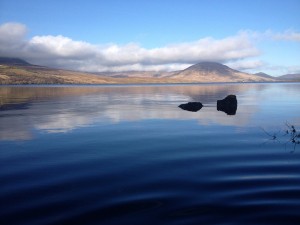
by John Lenters, PhD, Scientist, LimnoTech, Ann Arbor, Michigan, USA
It is now widely recognized that global and regional climate change has important implications for terrestrial and aquatic ecosystems. Recently published studies, for example, have revealed significant warming of lakes and reservoirs throughout the world. This has been evident not only in studies of individual lakes at specific sites (i.e., from “in situ” datasets), but especially in broader, satellite-based studies of lake surface temperature trends. Remarkably, these previous studies have also found that the observed rate of lake warming is sometimes greater than that of ambient air temperature. These rapid, unprecedented changes in lake temperature have profound implications for lake mixing, hydrology, productivity, and biotic communities.
Given the results of these previous studies and the observed rapid warming of lakes – as well as the important ecological and hydrologic implications – there has been a significant need to assemble and synthesize global records of lake temperature from both in situ and remotely sensed data sources. In response to this, the Global Lake Temperature Collaboration (GLTC), which began in late 2010, brought together an international group of investigators with interest in, and access to, global lake temperature records. Since the initiation of this effort, which started as a small group of 10 people from three countries, the GLTC project has now grown to over 70 investigators from 20 countries worldwide.
Throughout the development of the GLTC project, it has been recognized that a truly global database of lake surface temperatures needed to go beyond just the satellite records and include a diverse array of “on the ground” measurements from in situ data collection programs, such as those coordinated through the Global Lake Ecological Observatory Network (GLEON). The inclusion of both in situ and satellite-based records in the GLTC effort was, in fact, deemed essential – due to the value that each source of data brings to the table. On the one hand, remotely sensed measurements of lake surface temperature provide good geographic coverage of many of the world’s largest lakes, with most data going back to 1985. In situ data, on the other hand, fill some of the gaps left by the satellite record by providing temperature data for lakes that are too small to be “visible” by satellite. Many of the in situ records also go further back in time, and a few even provide information on vertical temperature profiles.

Rapid, unprecedented changes in lake temperature have profound implications for lake mixing, hydrology, productivity, and biotic communities. Credit: Mary Dillane. Location: Lough Feeagh, Co. Mayo, Ireland
The GLTC initiative has now assembled a database of summer-mean lake surface temperature for 291 lakes and reservoirs around the world, roughly doubling the amount of data previously available from satellite alone. This initial GLTC database – now published in Scientific Data – focuses on the period 1985-2009 due to the abundance of both satellite and in situ data. It represents the first global compilation of in situ and satellite-based lake surface temperature data and is publicly available to the broader community for analysis and interpretation. In addition to lake surface temperature, the GLTC database also provides information on climatic drivers at each lake site (air temperature, solar radiation, and cloud cover), as well as geomorphometric characteristics that may influence lake temperature (latitude, longitude, elevation, lake surface area, maximum depth, mean depth, and volume). Future iterations of the GLTC database are anticipated to include additional lakes, longer time periods, and vertical temperature profile data. This unique, global dataset will offer an invaluable, baseline perspective on lake thermal conditions in our ever-changing global climate.
A global database of lake surface temperatures collected by in situ and satellite methods from 1985–2009, by Sharma et al., is now available online at Scientific Data.
The Global Lake Temperature Collaboration (GLTC) is an international collaboration of over 80 scientists from 20 countries who are interested in understanding changing lake water temperatures.